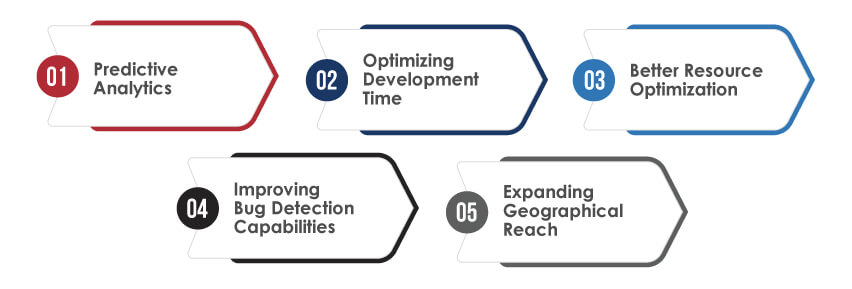Recommended Blogs
How is AI Transforming the User Testing Landscape?

- Importance of AI-powered User Testing
- How Does AI Transform User Testing?
- Business Benefits of Leveraging AI in User testing
- How Can Tx Assist with AI-Powered User Testing?
- Conclusion
In the dynamic web and mobile application development world, providing a seamless UX is of the utmost importance. This is why user testing is always integral to the design and development process. It helps address usability problems and provides users with what they expect. Although the current user testing tools have the necessary functionalities to run tests, such as platform testing and test planning designing, there are some improvement areas that need to be addressed to streamline the whole process. This includes:
• Analyzing user feedback and behavioral data manually is a hectic process.
• Small businesses or startups might not have access to costly testing tools.
• Hiring moderators and users is time-consuming.
• High chances of errors and a lot of time consumption when manually setting up and configuring tests.
• Failing to capture eye movements, subtle user emotions during manual analysis, and more.
Now the question is, “What can artificial intelligence (AI) do in all of this?”
Importance of AI-powered User Testing
Compared to traditional user testing methods, AI-powered user testing helps businesses detect usability issues much faster, allowing them to deeply understand user behavior and ensuring that their final product meets a usability benchmark before complete rollout. Its key benefits include:
• Fastly identifying usability issues that users might face when using the website or mobile app.
• Assist in uncovering gaps or missing functionalities that go unnoticed during manual testing.
• Analyzing and implementing direct feedback from users to improve design and functionalities.
• Helps in enhancing overall UX to meet user expectations.
• Businesses can further enhance their products to boost conversion and user retention rates.
How Does AI Transform User Testing?

User testing is critical to the software development lifecycle (SDLC). However, traditional QA methods like user surveys and manual testing cannot satisfy modern business and user requirements. They are also not scalable and are highly time-consuming. AI helps address these challenges by automating and upscaling the testing process. AI leverages data analytics and ML algorithms to streamline the user testing process. Here is how AI helps in optimizing the user testing process:
Predictive Analytics:
AI algorithms use historical data to build models identifying workflow areas impacting system performance. Enchanted predictive analytics facilitates the prediction of potential usability issues before they occur. This allows developers and designers to proactively address weak areas before they become serious, causing crashes or app shutdown issues.
Optimizing Development Time:
AI-powered test automation speeds up the user feedback cycle. Quicker results deliver a complete understanding of user behavior and preferences. This helps companies identify any miscalculations in their products and equip them to meet better changing user needs.
Better Resource Optimization:
People, Money, and Time are the three critical resource allocation factors. Intelligent automation engineers gather and analyze data 24/7. AI mitigates manual analysis, allowing businesses to concentrate their resources on more strategic tasks. They can optimize software features, remediate critical UX issues, and focus on innovation.
Improving Bug Detection Capabilities:
When bugs and faults occur post-deployment, mitigating them becomes costly and difficult. AI algorithms can create and analyze auto-generated scripts to identify possible bugs. These bug-hunting algorithms assist businesses in identifying problem sources by learning from data and spotting correlations. By doing so, they can address and fix those bugs pre-deployment.
Expanding Geographical Reach:
In-person testing has limited capabilities, making it harder for companies to collect diverse feedback. On the other hand, remote user testing enables companies to expand their geographical reach while welcoming diverse and representative feedback. In all of this, AI assists in translating languages to remove communication barriers. Businesses will have data from users from different regions and cultures. Also, remote user testing is convenient and cost-effective, significantly reducing the effort and time needed for user recruitment.
Business Benefits of Leveraging AI in User testing
Leveraging AI in user testing helps improve the overall user experience. The process involves using AI technologies to evaluate and optimize the software usability. It speeds up the testing process and offers comprehensive insights into user interactions, which is impossible with manual testers alone. Let’s take a look at some of the business benefits of integrating AI in the user testing process:
• It will reduce testing time by automating repetitive tasks by running multiple tests simultaneously, leading to faster software development cycles and quicker time-to-market.
• AI algorithms can analyze vast datasets to identify issues that might go unnoticed by manual testers. This would improve the test results’ accuracy, leading to better product quality.
• By automating testing processes, businesses can lower operating costs and overall testing workload.
• AI enables continuous testing and improvement throughout the development cycle, leading to higher software refinement and user satisfaction.
• AI-powered user testing is scalable, allowing businesses to handle large-scale applications and increase their testing scope.
• By analyzing user behavior patterns and preferences, AI offers deep insights into UX. This helps in optimizing software for a more seamless and engaging UX.
How Can Tx Assist with AI-Powered User Testing?
The key aim of user testing is to ensure the web or mobile apps meet the user’s expectations. Identifying bugs in the earlier stage will be easier to fix and involve less cost. At Tx, we offer user testing services that evaluate UX, interface design, and usability. We leverage the latest tools and technologies, like AI, ML, and automation, to ensure our comprehensive approach meets your user’s expectations, leads to higher engagement and conversions, and delivers greater business outcomes. Partnering with us will give you the following benefits:
• Ensure the product’s user-friendliness and deliver a higher level of user satisfaction.
• Proactively addressing usability issues to improve CX and retention rates.
• Leveraging in-house AI-powered accelerators like Tx-Automate and Tx-SmarTest to improve test processes.
• Reducing development costs by leveraging our test automation capabilities to identify issues at an earlier stage.
• Improving and building your brand reputation by delivering seamless UX.
Conclusion
Today’s businesses can achieve success only when their software, web, or mobile app products deliver a great CX with performance-rich features. And this can be achieved by implementing a proper QA testing process. AI-powered user testing is a crucial method in the current digital business age, which includes using top-end AI-powered tools and technologies to streamline the QA process. Tx, the leader in the digital engineering and QA field, assists in optimizing the UX of your product, website, or mobile application by leveraging digital tools and technologies. To learn more, Tx can help. Contact our experts now.
Discover more
Stay Updated
Subscribe for more info
